Gated content is high-quality content that’s available on your website, but only if a visitor provides their email address first. Then, they can read or download the content.
The question is, does gated content work for small businesses? Does it help generate leads and sales? Or does it just hide important content that could benefit your business in other ways if it wasn’t gated?
Yes, gated content can and does work for small businesses, as long as you’re careful about using it correctly! While having great content is important, sometimes you need to offer something extra special to convince people to join your email list or otherwise give their contact information.
That’s where gated content comes in. By strategically requiring visitors to share their email addresses to access your most valuable content, you can dramatically increase your lead generation and grow your email list faster.
In this detailed guide, I’ll show you exactly what gated content is, how to create it effectively, and most importantly, how to use it to grow your small business (and not affect your business negatively). Whether you’re just getting started with lead generation or looking to optimize your existing strategy, you’ll find actionable tips you can use right away.
What exactly is gated content?
Gated content is online material that requires users to provide information, such as an email address or subscription, before accessing it. Businesses use gated content to generate leads, build email lists, and offer exclusive resources like eBooks, whitepapers, or webinars. It also helps in audience segmentation and targeted marketing.
Think of gated content as a VIP area on your website. Visitors need to “pay” with their email address to get in.
This content can take many forms, such as:
- Downloadable guides or ebooks
- Exclusive webinars
- In-depth research reports
- Premium video content
- Case studies
- Templates and tools
- Expert interviews
For example, here’s a downloadable list of case studies on the Optimizely website:
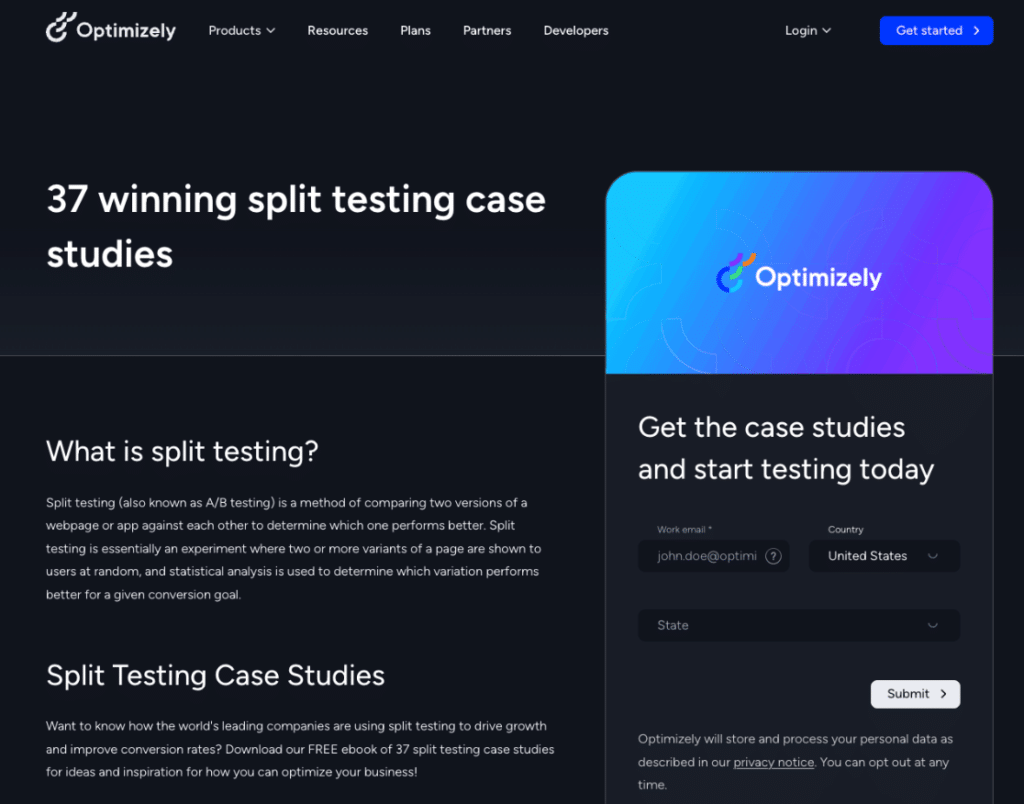
Why use gated content?
Simply putting a basic email signup form on your site often isn’t enough to grow your email list as quickly as you’d like to. Your site visitors need a compelling reason to share their contact information. Gated content solves this problem by offering clear value in exchange for an email address.
That said, the goal of gated content isn’t only to build your email list! Sure, that’s a key benefit, but gated content can also help you:
- Gather valuable information about your audience by adding more questions to the form
- Get high-quality leads
- Establish your expertise and authority in your field
- Get audience interest insights so you can tailor your content strategy to write more about what your audience is interested in
When to Use Gated Content
Gated content works best when you have content that’s super in-depth (like an ultimate guide), features original research or industry reports, provides some sort of step-by-step template or framework, or includes expert-level tutorials or training.
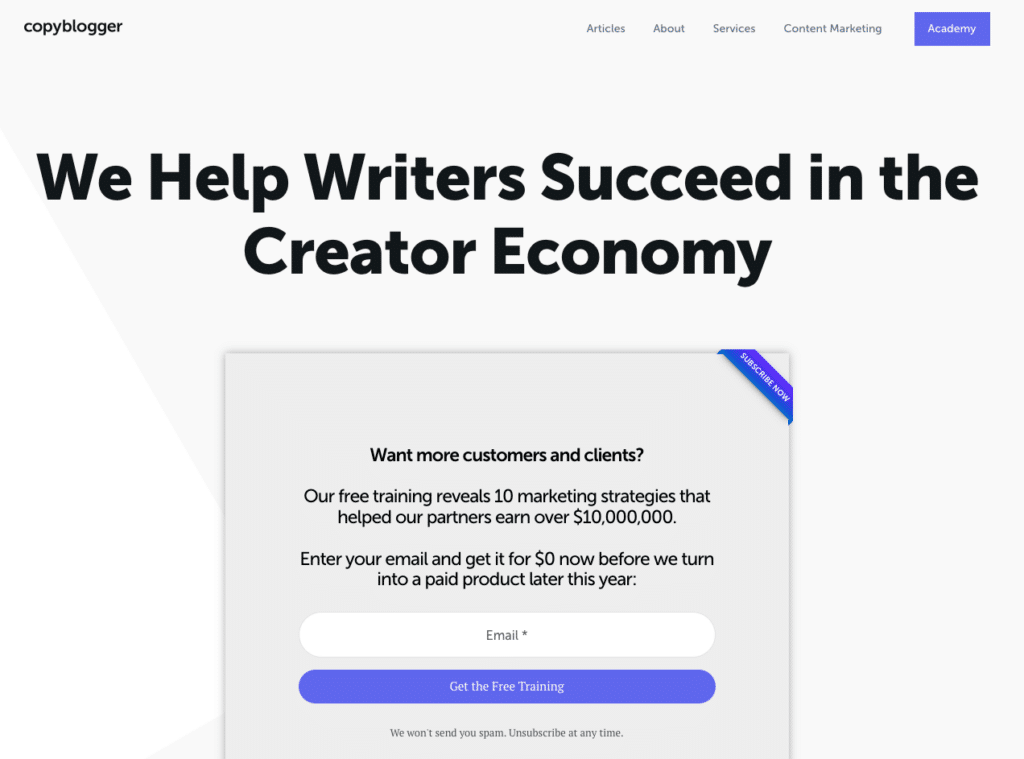
The most effective time to use gated content is when you’ve created something truly valuable that your audience can’t easily find elsewhere. The best gated content solves a specific problem or fulfills a particular need for your audience. For instance, a comprehensive guide about email marketing strategies including real-life examples might be worth gating, while a basic “what is email marketing” article should remain free.
Think about content that saves your audience time, money, or effort. Templates, worksheets, and tools often make excellent gated content because they provide immediate practical value.
The key is offering something that your visitors can’t easily find with a quick Google search or ChatGPT prompt.
When NOT to Use Gated Content
Now that you have some ideas about the types of content that work well as gated content, let’s talk about gated content no-nos. Gating the wrong content can actually hurt your website’s performance and damage your relationship with potential customers!
The primary argument against gated content is that it’s bad for SEO. Unfortunately, any content that you hide behind a form should also be hidden from search engines. After all, you wouldn’t want someone to be able to run a quick Google search to find the content without providing their information first.
So, any content you write that targets important focus keywords for your business should not be used as gated content. However, you can create multiple pieces of content around the same focus keyword with the intention of gating one.
For example, let’s say you want to use a comprehensive guide about email marketing strategies including real-life examples as gated content. To mitigate any negative SEO effects, just make sure you have a more basic guide such as “How to Create an Email Marketing Strategy” available on your site.
Also, make sure you’re not gating your trust-building content. This includes case studies, testimonials, and basic educational content. You want potential customers to easily access the information they need to feel confident about your brand before asking them to hand over their contact details.
How to Set Up Gated Content
My favorite way to create gated content is with OptinMonster. Its content-locking feature lets you restrict access to specific parts of your content until visitors enter their email addresses. You can choose to blur the restricted content or hide it completely until the form is completed.
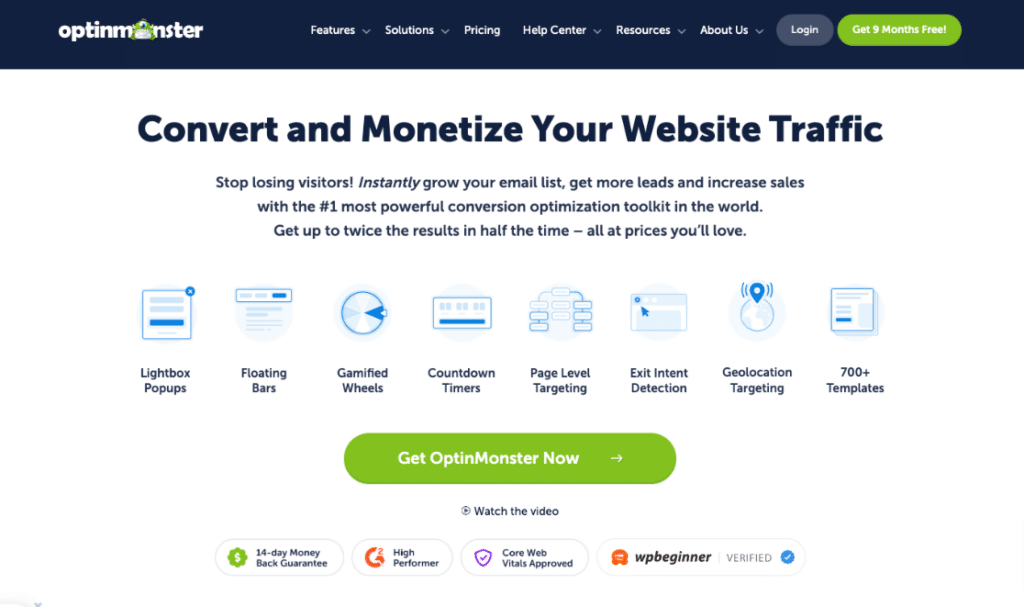
What’s particularly powerful about OptinMonster’s approach is that you can test different types of content gates to see what works best for your audience. You might find that gating an entire article works better than gating just a portion, or that offering a downloadable resource converts better than inline content locking.
Pro tip: Make sure the preview of your gated content clearly communicates its value. Use compelling headlines and descriptions that tell visitors exactly what they’ll get when they sign up.
Create Gated Content with OptinMonster
Now that you know what content to gate (and what not to), I’ll show you a simple way to gate your content using OptinMonster.
Step 1: Create Your First Gated Content Campaign
Start by creating a new campaign and choose the Templates option:
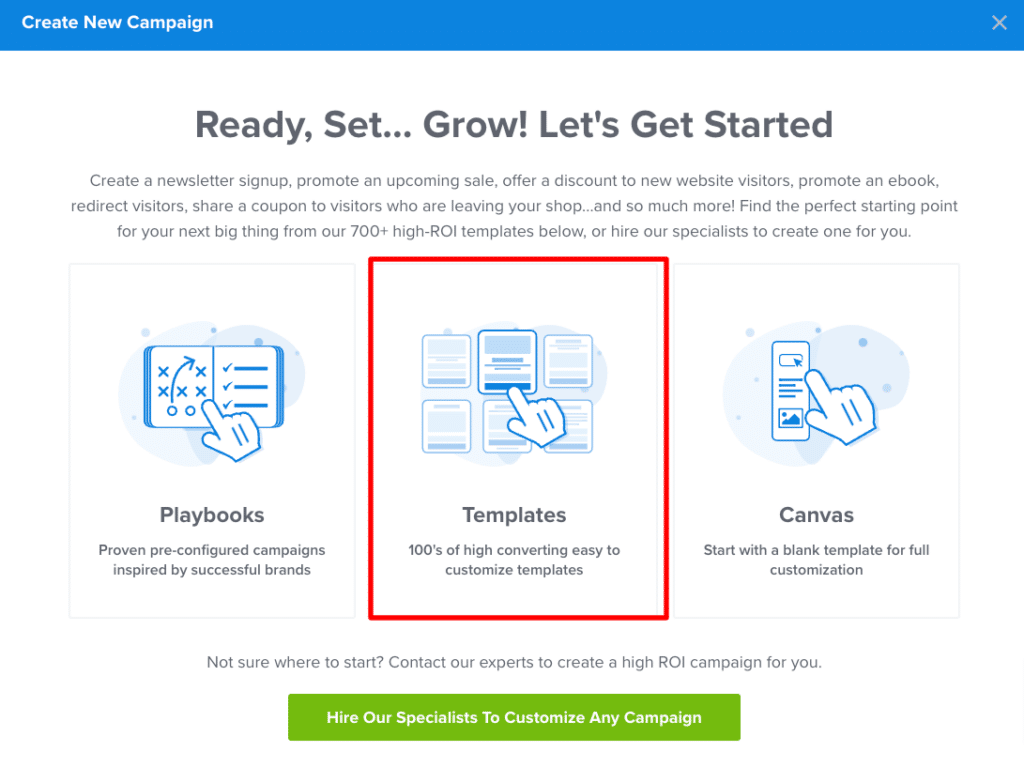
Then, choose the Inline Campaign type in OptinMonster and select the Unlock Gated Content template. This template is specifically designed for content locking and comes with pre-built elements that you can easily customize.
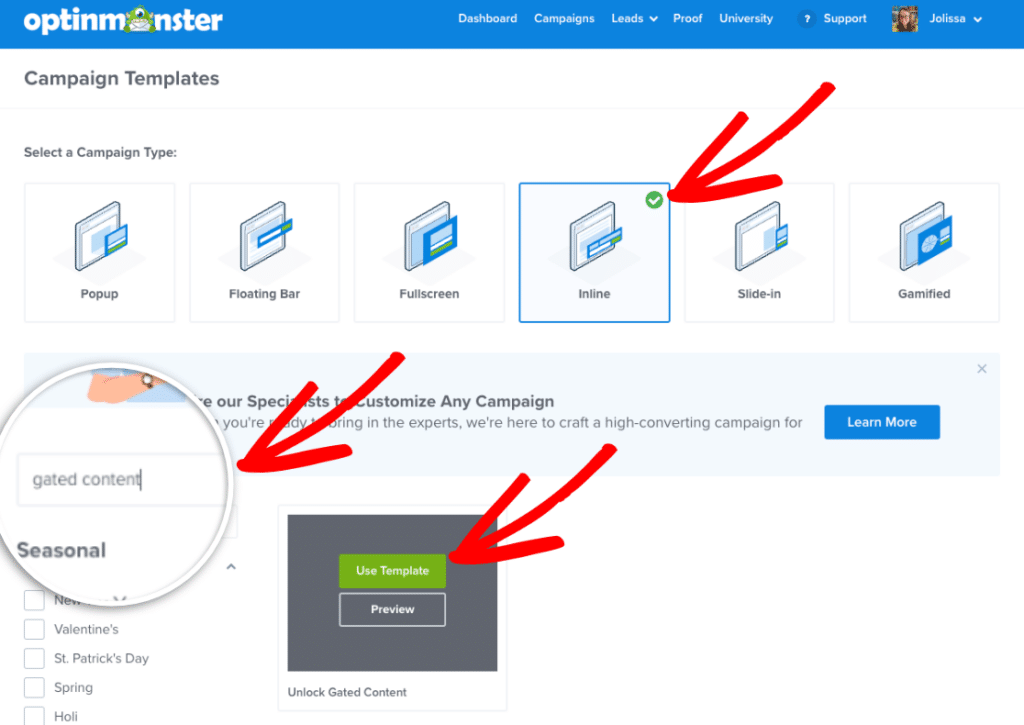
Step 2: Design Your Form
Your form should be simple and focused. While it’s tempting to ask for lots of information, each additional field reduces the likelihood that someone will complete your form. For most cases, just ask for an email address and perhaps a first name. If your goal is to gather visitor information, you can try adding another field or two.
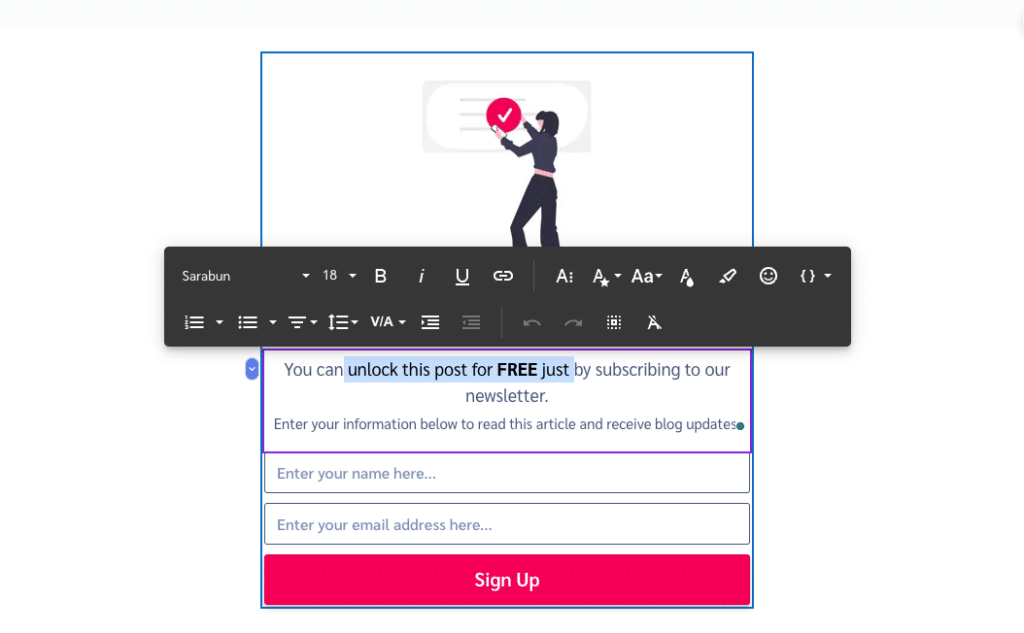
Pro tip: Make sure your form clearly communicates what visitors will get in exchange for their information. A strong headline and brief description can significantly improve your conversion rates!
Step 3: Set Display Rules
OptinMonster lets you control exactly where and when your gated content appears. Most likely, you want to configure it to lock a certain page. To do that, head to the Conditions tab and put the correct URL in the “is any page” box:
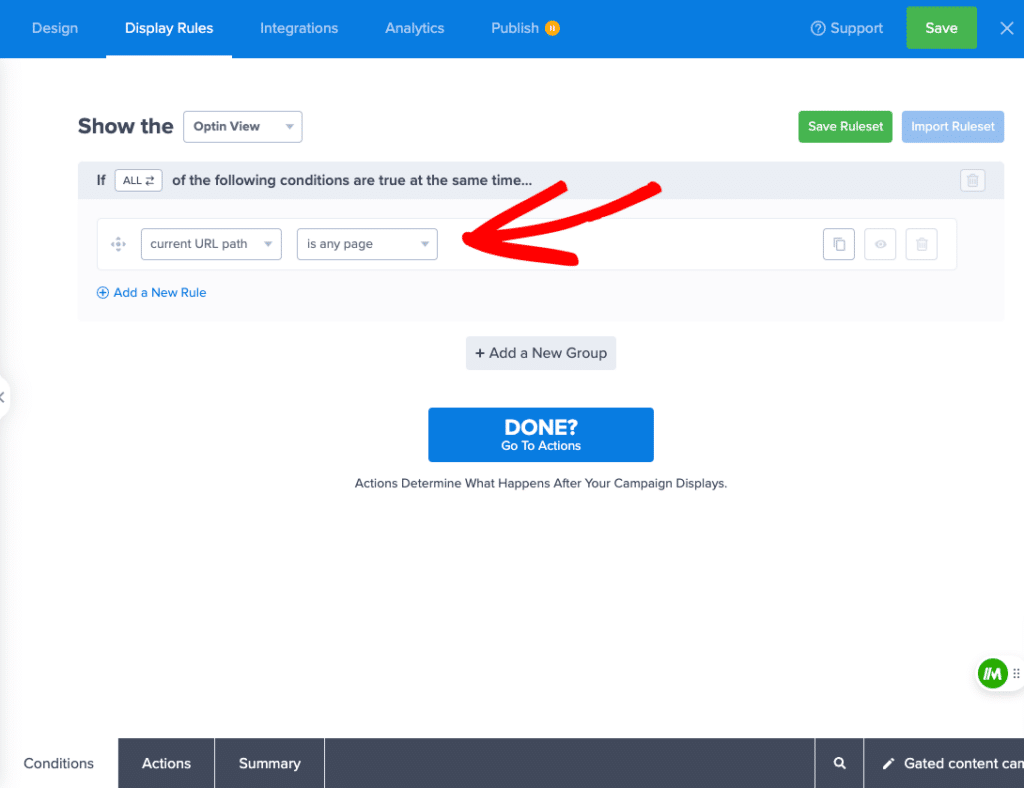
When you’re done, click the blue button to proceed to Actions.
Step 4: Set the Content Locking Action
Now, you need to enable content locking. On the Actions page, switch Enable Content Locking on and choose whether your content is blurred or removed. Then, set your cookie settings for Remember a visitor who has seen this campaign… to forever.
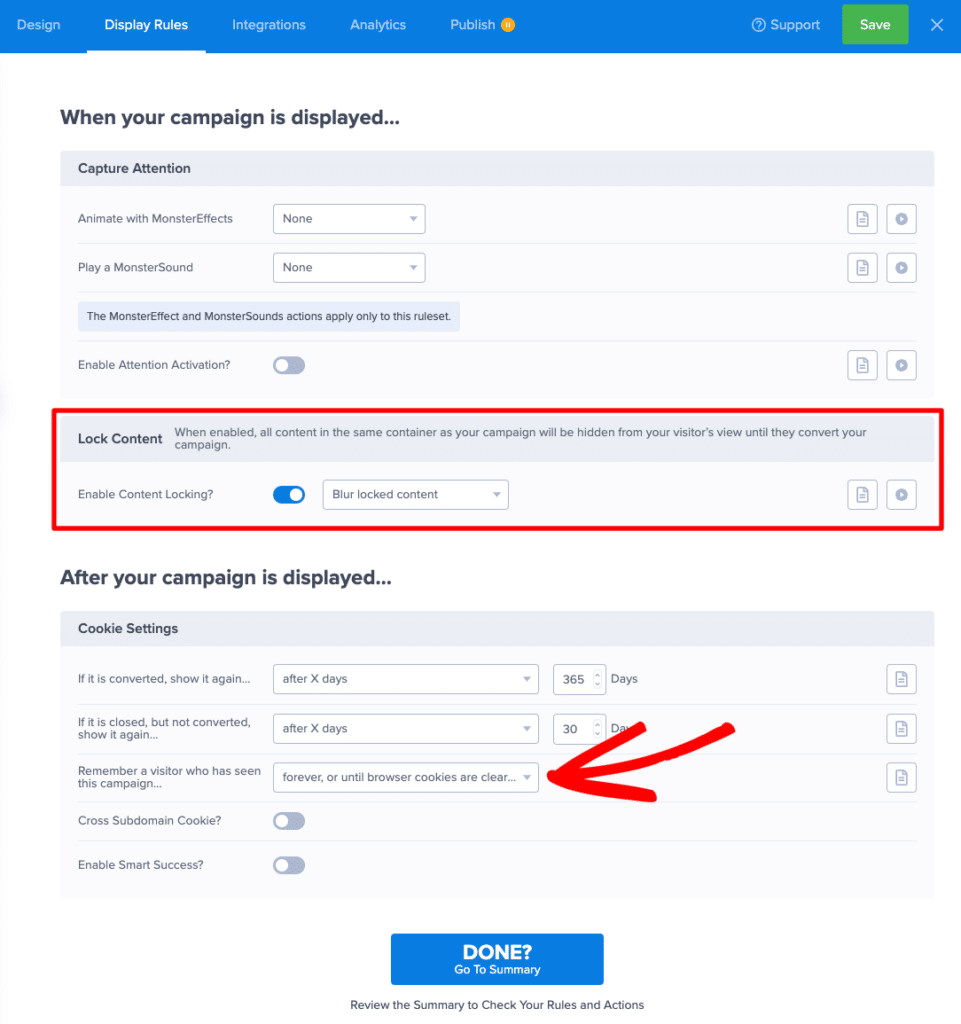
That’s it! Those are the basics of setting up a content-locking campaign in OptinMonster.
You’ll just need to add your campaign to the content you want to lock. In WordPress, I just added the OptinMonster block at the point where I wanted to lock the content:
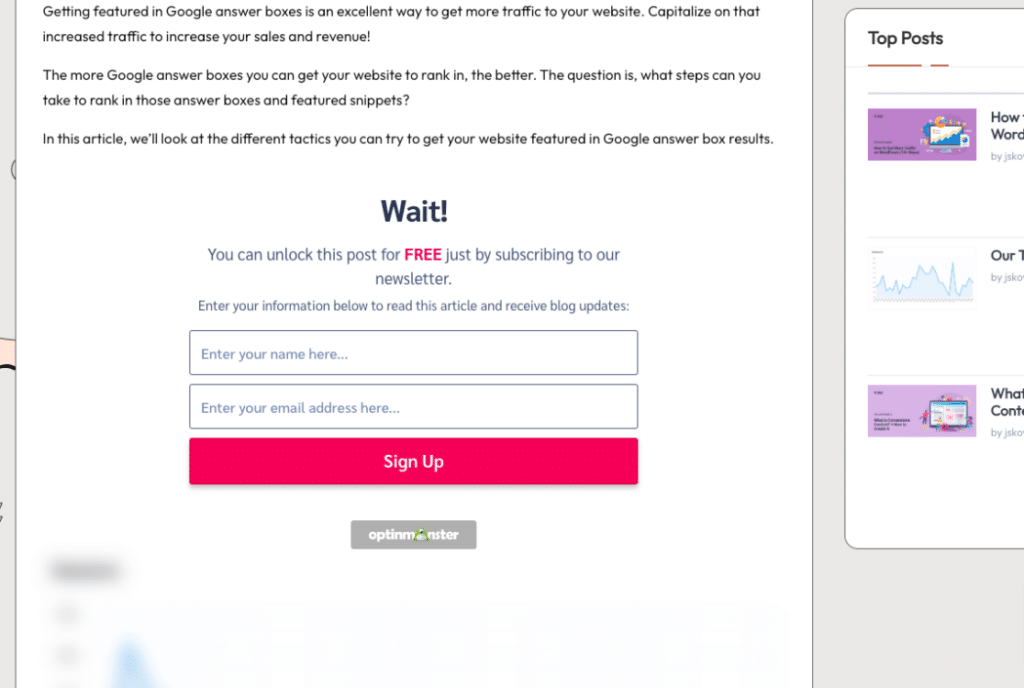
But how do you know if your locked content is working? Next, I’ll show you how to measure the success of your new gated content campaign.
Measuring the Success of Your Gated Content
Understanding how well your gated content performs is crucial for optimizing your lead generation strategy. Is gating the content paying off? How can you tell?
Let’s take a look at a few key metrics you’ll want to watch to determine whether or not your gated content is successful.
Your conversion rate is the most important metric to track. If you’re seeing rates below 2-3%, your offer might not be compelling enough, or your form might be asking for too much information. On the other hand, conversion rates above 10% usually indicate you’ve found a sweet spot with your content offering.
Find your conversion rate any time inside your OptinMonster dashboard:
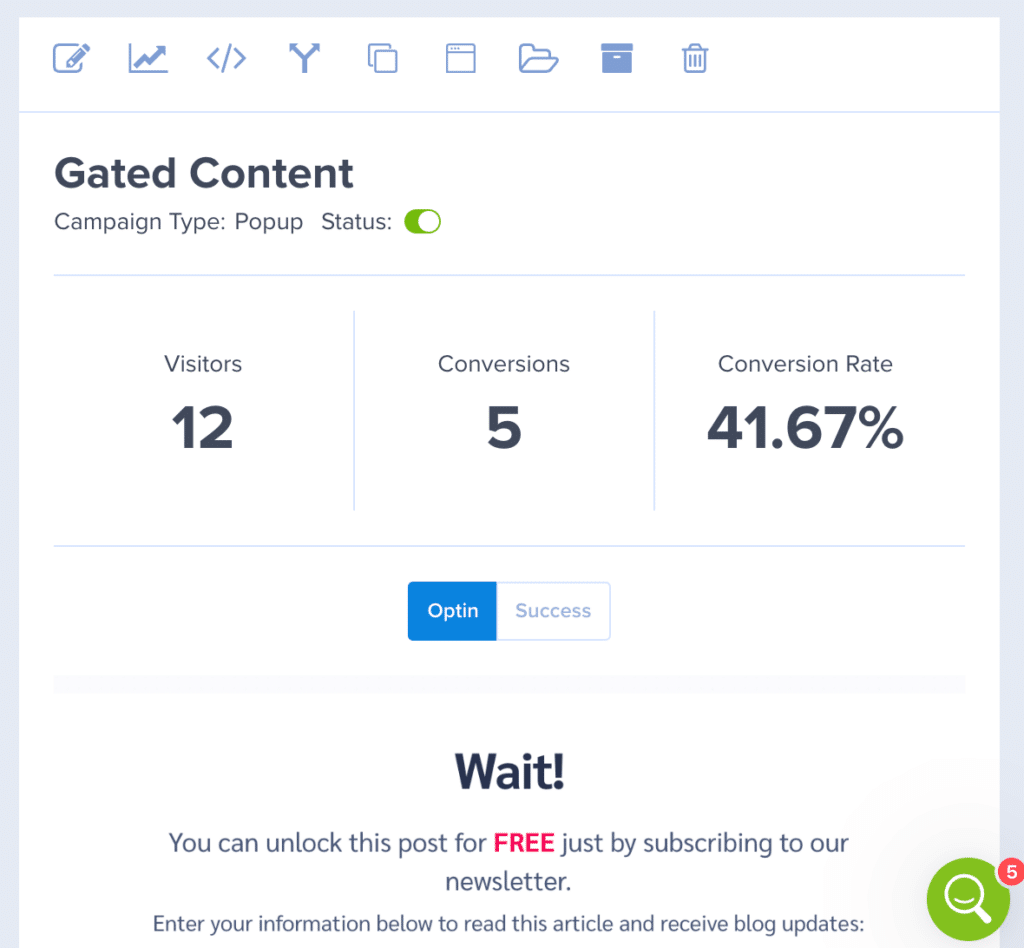
However, keep in mind that those conversion rate numbers are NOT one-size-fits-all. If you’ve only got a 1.5% conversion rate but those few people went on to become customers or clients who spend quite a bit on your products or services, that might make that low conversion rate worth it for you.
Also, keep an eye on how your new subscribers are interacting with any emails you send them. If you segment those gated content sign-ups into a separate list, you can see whether they’re opening and clicking on your emails. Does the click-through-rate live up to your expectations? Are those visitors spending time on your website, engaging with your content?
If your website is built in WordPress, try tracking your traffic right inside your dashboard with MonsterInsights.
MonsterInsights is the best Google Analytics plugin for WordPress. Quickly and securely install Google Analytics on your site, set up advanced tracking features, and simplify Google Analytics reports with a whole dashboard of easy-to-understand data.
For example, do you tag your email campaigns with UTM codes? Check how they’re doing any time in the Campaigns report:
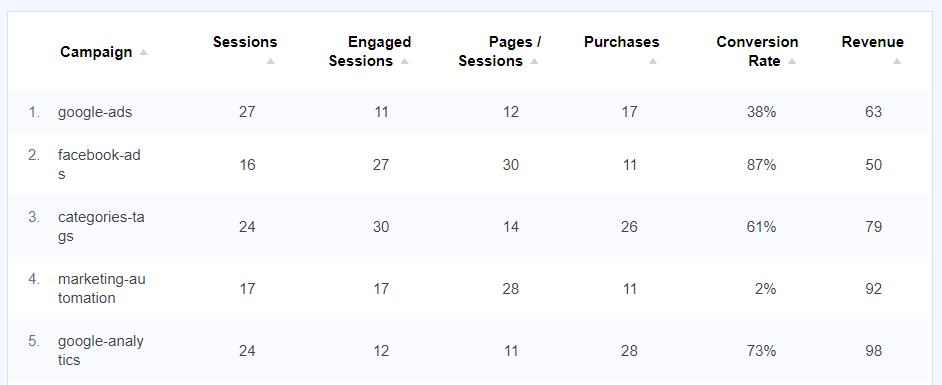
Learn more about MonsterInsights now!
Optimizing Your Gated Content Campaigns
Once your gated content is available for long enough to collect a good amount of data, it’s time to analyze and optimize. If you’re using OptinMonster, you can use their built-in A/B testing functionality to try out different versions of your offer.
Start by testing one element at a time to understand what impacts your conversion rates. OptinMonster’s A/B testing feature lets you experiment with:
- Form Design: Try different layouts, colors, and button styles. Sometimes small design changes can make a big difference. I’ve seen conversion rates increase just by changing button colors or form placement.
- Messaging: Test various headlines, descriptions, and calls to action. Focus on communicating the value of your offer clearly and convincingly. What problems does your content solve? Make sure that’s front and center.
- Timing and Triggers: Experiment with when your content gate appears. You might find that waiting until visitors have read 20% of your content leads to higher conversion rates than showing the gate immediately, for example. Sometimes showing more content before the gate increases conversions because visitors get a better sense of the value you’re offering. Other times, a shorter preview creates more curiosity.
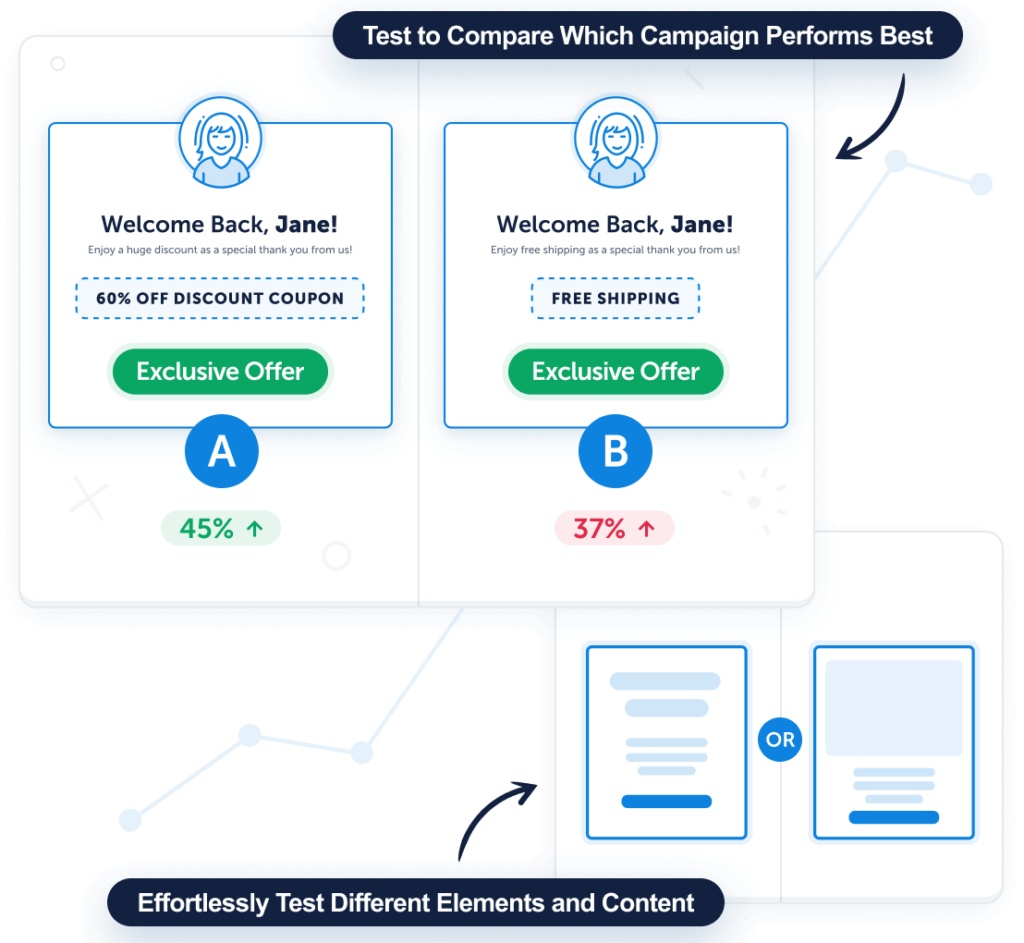
You might find that even small changes can lead to significant improvements in conversion rates!
Content Gating Essential Tips
There are just a couple more things you should think about when using gated content:
Follow Up with Your Leads
Remember, getting the email address is just the first step. Have a plan for what happens next:
- Send an immediate follow-up email with the promised content
- Create a welcome sequence to engage new subscribers
- Plan how you’ll nurture these leads toward becoming customers
Waiting too long to interact with those new subscribers could increase your unsubscribe rate. Don’t let them forget you and your super beneficial content!
Keep Your Promise
The fastest way to lose a new subscriber is to under-deliver on what you promised. Make sure your gated content is even better than what your visitors expected. If you promise a comprehensive guide, it should be truly comprehensive and packed with actionable information.
Don’t Forget About Your Content
If you created an amazing piece of content and visitors are downloading it, just remember to keep it on your radar. Is there anything, like stats, that needs to be updated every 6 months or year? Keeping it fresh and just as helpful as the day you published it is key to its longevity.
That’s it! You now have everything you need to start using gated content effectively on your website. Remember to test different approaches and keep measuring your results to find what works best for your audience.
I hope you enjoyed this gated content guide. You might also want to check out:
How to Create a Content Strategy (Backed by Real Data)
16 Content Marketing Metrics That Matter the Most
Improve Content Marketing ROI in 10 Steps
Not using MonsterInsights yet? Get started today!
Finally, stay connected with us on YouTube for the latest Google Analytics and WordPress tips and tutorials.
Gated Content FAQ
What is gated and ungated content?
Gated content requires users to provide information, such as an email, before accessing it. This helps generate leads and build email lists. Ungated content is freely accessible without restrictions, increasing visibility and brand awareness. Businesses use gated content for lead generation and ungated content for broader audience reach.
How much content should I gate on my website?
Start with gating just your most valuable content – usually about 10-20% of your total content. The rest should remain freely accessible to help attract and engage visitors.
Is gated content good for SEO?
Gated content is not ideal for SEO because search engines cannot index it. While it helps with lead generation, it limits organic traffic and visibility. To balance SEO and lead generation, businesses can offer partial content for indexing while requiring a form submission for full access. Also, make sure not to gate high-value SEO content.
What’s the ideal length for gated content?
There’s no perfect length – it depends on your topic and audience. The key is providing enough value to justify asking for contact information. This could be a 5-page guide or a 50-page ebook, as long as it delivers real value.
How can I promote my gated content?
Use your blog posts, social media, and email newsletter to promote your gated content. Consider creating “preview” content that gives visitors a taste of what they’ll get when they sign up.
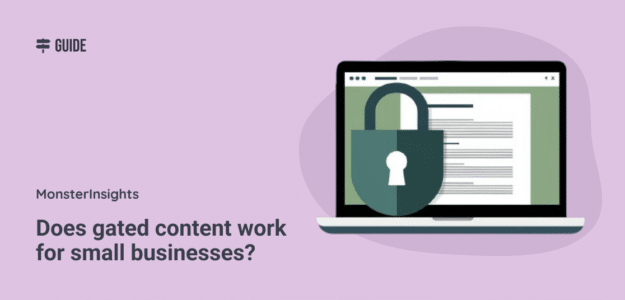
Really useful information!